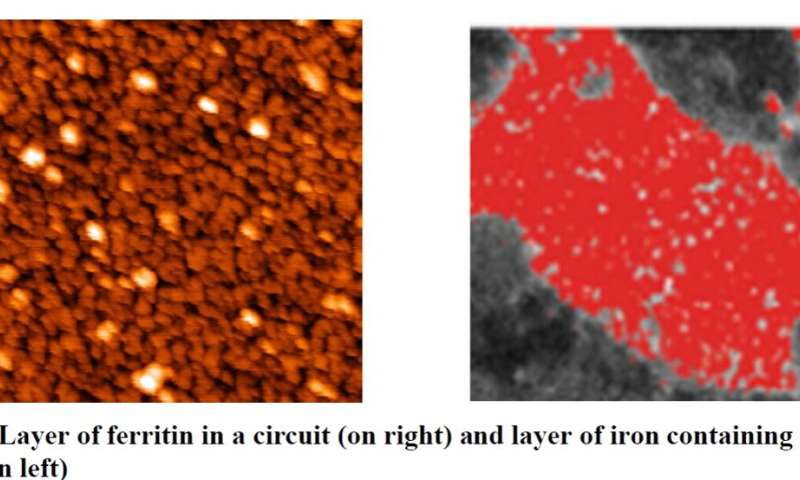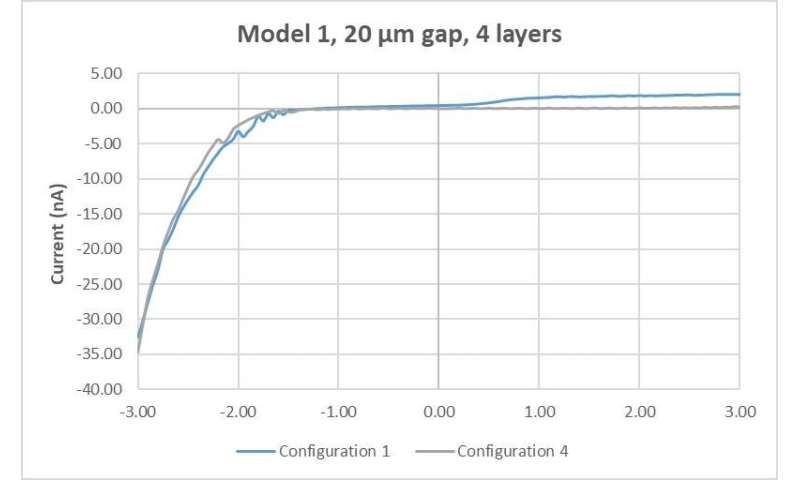Scientists discover quantum mechanical switching in ferritin structures similar to those found in neural tissue

Quantum mechanics generally refers to the wave-like properties of things that are commonly considered to be particles, such as electrons. This article discusses evidence of a quantum mechanical switching function that is performed by strictly biological structures—ferritin protein layers that are found in cells including neural tissue.
Many scientists are investigating quantum biology, which is the application of quantum mechanics to investigate biological functions. It has recently been used to answer a number of previously unanswered questions, such as the mechanisms behind photosynthesis and the way birds can perceive magnetic fields. These quantum biological effects generally involve electrons hopping or tunneling over distances of several nanometers, behavior that is incompatible with particles but which makes sense with waves.
Ferritin is a spherical iron storage protein that is found in plants and animals. Early studies of ferritin to look for quantum mechanical effects were conducted at cryogenic temperatures, because it was thought that biological structures were too "warm and wet" to exhibit such effects. Those studies were somewhat inconclusive. But when ferritin was subsequently electrically tested at room temperature, it was discovered that electron tunneling was occurring.
Layered accumulations of ferritin have recently been observed in many tissues, including the brain, melanosomes and placental tissue. Building on those prior discoveries, scientists led by Dr. Cai Shen at the Ningbo Institute of Materials Technology and Engineering have demonstrated that disordered layers of ferritin not only conduct electrons over distances as great as 80 microns by sequential tunneling, but can also form a Mott insulator, to switch from a conducting to non-conducting state. An example of the similarity between the tested ferritin layers and the layers of ferritin in tissues is shown in Figure 1, at approximately the same scale (iron is shown in red in the photo on the right, with round shapes that indicate ferritin).
Parametric Test Design
Dr. Shen's lab formed disordered layers of ferritin using a layer-by-layer technique that had previously been developed and tested, and which was shown to result in electron transport over distances as great as 40 microns. In order to determine whether those ferritin structures could provide a switching function, the layers were formed on a four electrode device that was designed to allow parametric studies to be conducted using different current paths under different circuit conditions. In the absence of sufficient order in the layers, no appreciable current was measured, which demonstrates that the measured currents are not due to ferritin's bulk material properties, but rather due to the quasi-ordered arrangement of the ferritin cores in the layers.
In Figure 2, the measured current as a function of the applied voltage between two different electrode configurations is shown for a device with four layers of ferritin and a 20-micron gap. This current-voltage response provides evidence of a very clear diode-like switching behavior, which is believed to be due to Mott insulator formation. In a Mott insulator, strong electron-electron interactions can result in blocking of current flow due to the formation of an energy gap when available electron orbitals in the ferritin cores become filled. In other words, the electrons "fill up" orbitals that would otherwise be available for tunneling current, which turns the conducting ferritin layers into an insulator.

Voluntary action selection
The tests were designed to study electron transport in ferritin structures that are similar to ones found in the substantia nigra pars compacta (SNc) and locus coeruleus (LC), groups of neurons that are found in the brain. Parkinson's disease research has shown that destruction of the neurons of the SNc results in the loss of the ability to initiate voluntary action, and that the destruction of neurons in the LC results in impaired cognitive processing. The results of these tests demonstrate that ferritin layers in those structures could provide a switching function that coordinates those groups of neurons to perform action selection and cognitive processing, respectively. While not conclusively establishing that these structures provide that function in those groups of neurons, these tests indicate a need for additional research and testing of tissues where such ferritin accumulations are found, to determine whether the electron transport and switching functions of such ferritin formations are used for such important biological functions.
While quantum biology in general and the study of electron transport in ferritin in particular are still relatively new, the discoveries that have been made to date indicate the need for additional investigation. There is a tendency to view ferritin as "only" an iron storage protein, but it is unlikely that ferritin evolved over hundreds of millions of years with a quantum mechanical electron transport mechanism that has not been utilized by nature. If that mechanism exists and is used to perform action selection and cognitive processing, it could have important implications for our understanding of how the brain functions.
The study, "Indication of Strongly Correlated Electron Transport and Mott Insulator in Disordered Multilayer Ferritin Structures (DMFS)," is published in Materials.
This story is part of Science X Dialog, where researchers can report findings from their published research articles. Visit this page for information about ScienceX Dialog and how to participate.
More information:
Christopher Rourk et al, Indication of Strongly Correlated Electron Transport and Mott Insulator in Disordered Multilayer Ferritin Structures (DMFS), Materials (2021). DOI: 10.3390/ma14164527
Bio: I am a patent attorney with B.S.E.E. and M. Eng. degrees, and help my clients protect semiconductor devices and processor architectures. I conducted research in industry and the government before deciding to go into patent law. While I still practice patent law full time, I have been interested in science in general and quantum mechanics in particular for most of my life. My research into this specialized field, including designing and funding the tests discussed in this article, has been a rewarding avocation.